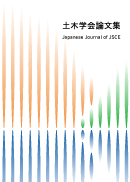Volume 79, Issue 19
Special issue(Tunnel Engineering)
Displaying 1-5 of 5 articles from this issue
- |<
- <
- 1
- >
- >|
Special Issue (Tunnel Engineering)Paper
-
2023Volume 79Issue 19 Article ID: 23-19001
Published: 2023
Released on J-STAGE: March 07, 2024
Download PDF (6913K) -
2023Volume 79Issue 19 Article ID: 23-19002
Published: 2023
Released on J-STAGE: March 07, 2024
Download PDF (4664K) -
2023Volume 79Issue 19 Article ID: 23-19003
Published: 2023
Released on J-STAGE: March 07, 2024
Download PDF (4331K) -
2023Volume 79Issue 19 Article ID: 23-19004
Published: 2023
Released on J-STAGE: March 07, 2024
Download PDF (1785K) -
2023Volume 79Issue 19 Article ID: 23-19005
Published: 2023
Released on J-STAGE: March 07, 2024
Download PDF (3398K)
- |<
- <
- 1
- >
- >|
